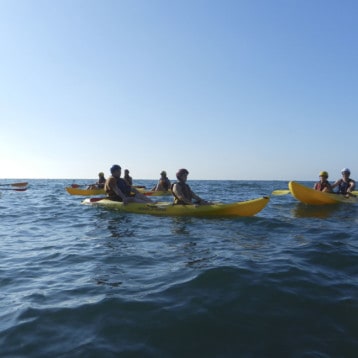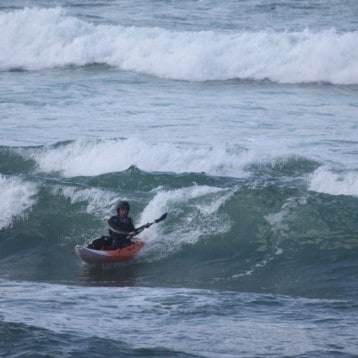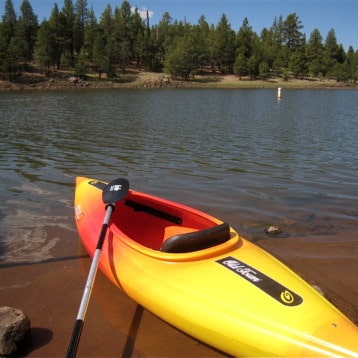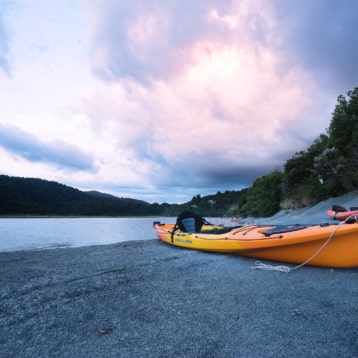Most kayaks are unable to take on the challenging waves of the ocean. You wouldn’t want to even attempt the crashing waves that you can find on the shore. If, however, you’ve got a protected inlet where you can get out onto the salty waters of the sea, then this Salty Dog has some tips for you to have a beautiful day on the ocean waters.
Table of Contents
Here Is the Best Chart for Ocean Kayaks
The best kayak for ocean navigation needs to have a few specific features and qualities to it for a good experience. Here are the best of the best products that have been made right now.
What Are the Salty Dog’s Favorite Ocean Kayaks?
Sun Dolphin Sit-in Fishing Kayak


If you’ve got some calm waters and want to do some close to shore ocean fishing, then this beautiful kayak will help you get that done for a pretty amazing price. It’s a little less than 10 feet long, but this adds to the stability of the boat. There is interior foot bracing and back supports that are both adjustable so that users can get a true customized fit. Two flush mount fishing rod holders round out the advantages – and you can’t forget about the third swivel rod holder.
Advanced Elements AdvancedFrame Convertible Inflatable Kayak


If there’s a little chop out on the water, a lot of ocean kayaks are going to force you to stay home. Don’t be fooled by the fact that this kayak is inflatable – it is strong. It’s got strong supports within the seating environment, which can fit two people, and there are aluminum ribs within the bow that help to define the shape of the boat and give it a little extra stability. There are also three seating locations so you can use this boat as a solo kayak without needing to supply a ton of extra weight to make it useable.
Sun Dolphin Aruba Sit-in Kayak


This ocean kayak was built for turning and tracking. It’s 10 feet long, just 30 inches weight, and weighs 40 pounds with a sit-in design. The seat is adjustable and comfortable and the high back support helps to relieve some discomfort. The shock cord rigging isn’t the best it could be, but there are adjustable foot braces and a spray deflector collar that will help create a better overall kayaking experience.
Ocean Kayak Scrambler 11 Sit-On-Top Recreational Kayak
If you like the idea of a sit-on-top design and you’re looking for something that is fairly basic, then this could be the best ocean kayak for you. It’s got some foam for the seat so that you don’t get cramps and lower back pain from a long day of paddling. There are also overlapping foot wells included in the design that are nice because they accommodate virtually any leg length. The 6-inch Cam Lock hatch helps for dry storage items as well. All in all, this is a pretty good investment.
Rave Sea Rebel Inflatable Kayak 2011
Made with a heavy-duty nylon cover and a PVC bottom, this sit-on-top kayak isn’t going to handle the waves along the shore, but it will help you get out onto the calm waters of an interior sound pretty effectively. The gliding of this boat is what really makes it stand out, but this is a custom kayak, so don’t order it today and expect to get it tomorrow. On the other hand, you’ll have a kayak for calm ocean waves made especially for you – and it weighs just 19.5 pounds.
Knowing the Ocean Kayaking Basics Is Important
The focus of ocean kayaking is usually on posture and paddling [or the fact that you need to bring water with you], but the Wet Release is also an important skill to know – and practice. Anything can happen when you’re in a kayak on the ocean. If you flip over and find yourself underwater, it can be scary if you don’t know what to do.
- Make sure you lean forward as the first thing you do.
- Push the bottom of your kayak with your paddle.
- Release the spray skirt that has you affixed to the kayak so that you are no longer constrained.
- Take a moment to make sure that the skirt has been completely removed and then get out of the boat.
If you’ve never flipped over in a kayak before, then being in the cold, salty ocean is enough to even give this Salty Dog a few shivers. You don’t mess with the power of the ocean. You respect it. With that being said, if you’re wearing the REQUIRED life vest, then you’ll propel out of the boat and float to the surface pretty quickly.
FAQs
What Is the Advantage of the Best Ocean Kayak?
The best advantage that comes with an ocean kayak is that they are very easy to paddle and quick to forgive. Remember to relax while you are paddling. A death grip on your paddles isn’t going to move your kayak any faster or slower. Make sure you are sitting with a good posture, having your knees slightly bent, but no too far so that you bang your knees together as you are paddling.
The one place where there is no forgiveness with the best ocean kayak, however, is the offshore breezes that can develop in the sea. If these winds fire up, and they will, it will make it difficult to return to shore. Always be aware of the weather, make sure you’re dressed for it with the right kayaking gear, and make sure someone knows where you plan on paddling.
What Are the Prices of the Best Ocean Kayaks?
The best ocean kayaks tend to be a little more expensive then the other types of kayaks that are available today. This is because they need to be more reinforced and made from better materials to stand up to the ocean environment. For that reason, you’ll find that most kayaks built for the ocean are priced in the $1,000 range.
Do I Have to Carry a Life Jacket with Me?
A life jacket is a vital piece of safety gear when you are out on the water. Although safety regulations may vary from location to location, it is advisable to wear a life jacket every time you are kayaking in the ocean. You can also have any other inflatable device that will help to keep you afloat in an emergency instead of a life jacket.
However, it is important that you have it with you all the time. You can store it in the rear bungee cord storage space or on the deck when you are not wearing it so that you are prepared for any emergency.
The importance of a life jacket for a beginner cannot be stressed enough. You never know when the weather may turn stormy; that is why having a life jacket at hand at all times is best.
Is it Hard to Kayak in the Ocean?
Although ocean kayaking is an exhilarating sport, it can be quite intimidating for beginners. If you are new to kayaking, you will need a good instructor who can help you learn some basic skills and give you a few lessons on safety. Once you have acquired these skills, you can easily go out into the ocean and enjoy kayaking.
You will find ocean kayaking different from kayaking in a bay as you will have to deal with strong currents, choppy waves, and winds. Ocean kayaks are designed to perform efficiently in windy conditions and stormy weather, which makes it easier to navigate them in the ocean even when it gets rough. It is also advisable to take all the necessary precautionary measures when you are kayaking in the ocean.
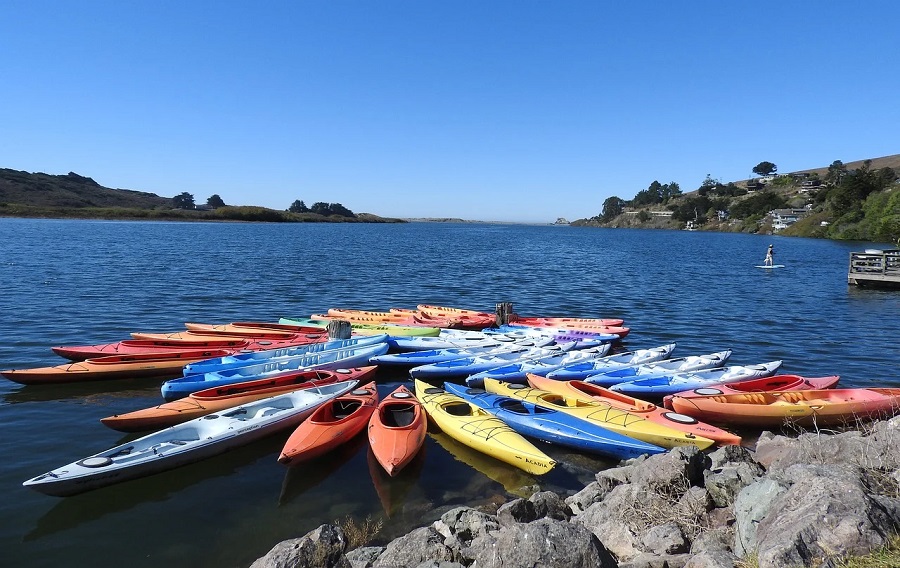
Different Types of Ocean Kayaks
Kayaks are quite popular among people because it is an activity that provides a fitness workout together with peaceful time on the water. It is a totally different experience from paddle boarding on a lake or out in the ocean. Strong currents and winds can prove to be a big obstacle when you are out kayaking. Luckily, ocean kayaks are designed to withstand rough conditions, which makes them safer and keeps the kayaker as dry as possible.
There are many things that you have to take into consideration when choosing an ocean kayak for yourself. However, the biggest question is what type of kayak should you buy? This greatly depends on how you will use it.
Single or Tandem Kayak
If you are going to be kayaking with your partner, then you will have to decide between a single and a tandem kayak. Single kayaks typically cost more than a tandem kayak and can be twice as burdensome to store and transport. If you and your partner are frequent kayakers and enjoy working as a team, then it might be best to invest in a tandem kayak.
Although a tandem kayak will be heavier and bigger than a single one, it will be more difficult to store and transport two single kayaks. Moreover, they take more space on your truck bed or car roof and storage at home.
On the other hand, there are instances when a single kayak will be preferable despite the extra effort and cost involved in getting them around. In the end, it all depends on your usage and choice.
Sit-in or Sit-on-top Kayak
Sit-on-top kayaks are perfect for beginners, rough weather conditions and warm temperatures. They are highly stable and provide a secure surface to kayakers when sailing on top of the waves.
Sit-on-top kayaks are designed with small holes known as scupper holes which makes them self-bailing. As a result, the water inside the kayaks drains on its own.
It is easier to get in and out of these kayaks as compared to sit-in kayaks which makes them better for diving or surfing. They also have more storage space as the interior of the kayak is unoccupied, thus making them ideal for fishing.
However, there is a downside to these kayaks. Since you are sitting on top instead of inside a kayak, you are bound to get wet.
Sit-in kayaks are constructed to shelter your lower body, thus making them warmer and better for adventure in cold temperatures. These kayaks provide a better paddling angle as the kayaker is nearer to the water, which ensures less strain and better propulsion.
However, in case the kayak flips, it can be quite difficult to free yourself, making these kayaks dangerous, particularly for beginners.
Ocean Kayak Features
Few things can compare to the outstanding experience of gliding in a kayak at the water level. Moreover, it gives kayakers a new appreciation of the ocean. However, it is vital to remember that a good-quality kayak will get you there safely and comfortably. From enjoying a string of shore camping excursions to exploring coastal inlets for a day, an ocean kayak is a unique way to enjoy extraordinary sea experiences.
Choosing a kayak for the ocean requires some serious thought, beginning with some exclusive details about yourself. Every kayaker is unique in strength, shape, and size and has a distinctive idea of how to use his kayak on ocean adventures. It is better that you try out the function and feel of some models to find what works best for you.
There is a wide range of kayak models available in the market. Some deliver the highest speed possible, while others ensure the comfort of kayakers all day long. Therefore, before choosing a kayak that is best for you, you must analyze features like the cockpit-style, length, and width of the kayak, construction quality, stability levels, etc. to find out which features are non-negotiable for you and what can be compromised.
Stability
Ocean kayaks need extra stability, which is why the base of an ocean kayak is designed with two types of stability – primary stability and secondary stability. Primary stability measures the stability of the kayak in resting mode when it is in flat waters. Secondary stability, on the other hand, determines the ability of a kayak to stay put when it is tipped to one side. Good secondary stability is more important in an ocean kayak as it allows the kayak to stay afloat in ocean waters.
Although it may seem a bit odd, the more unstable or tippy a kayak feels, the more stable it will be in turbulent waters. A kayak that seems stable is more likely to experience instability in ocean conditions as compared to one that feels like it tips or moves a lot.
Ocean kayaks are also designed with V-shaped hulls that make them more stable in the erratic currents and waves of the open water. They rely on a combination of material strength, hull design, and weight distribution to deliver stability and good balance on the ocean.
Size and Weight
Ocean kayaks are typically greater in length, width, and weight compared to recreational kayaks used for lakes and rivers. Their greater weight and width ensure stability in the ocean. The length of an ocean kayak ranges from 11.5 to 17 feet. This greater length gives the kayak better traction, allowing it to continue ahead through the water.
Beginners should choose a kayak that is at least 20 to 36 inches wide as it will provide them with greater control and stability while they are getting accustomed to the feel of currents and waves at sea. The best ocean kayak for you is one that fits you perfectly and is designed with the necessary width and length to support you comfortably.
Also, make sure to check the total weight ratings of your kayak and decide how you will make it balance and perform once it is fully loaded.
Comfort
There are many aspects that affect the comfort of an ocean kayak. The available legroom in a sit-in kayak, the size of the seat opening, and the padding and angle of the seat can affect the paddler’s comfort.
Make sure that you choose a kayak with a cockpit that does not restrict your movement and gives you enough room to paddle through the waves easily.
Storage Space
It is also vital to give storage some thought when choosing an ocean kayak. Your need for storage space depends on what you will be doing with the kayak. For camping or fishing, you will need a kayak that has more storage space as you will be bringing along a lot of gear. However, you will not need much storage space if you are going to be using your kayak for day trips along the coast.
Pay attention to the size and weight of the gear that you will be bringing along on your adventures on the sea. Consider things like accessibility of gear, outer shell tie-downs, and hatch doors to make sure that you find a model that has the storage space to stow all your gear easily and securely.
Durability and Strength
Ocean kayaks are constructed from different materials, ranging from fiberglass resin to plastic composites. A good-quality, durable ocean kayak is one that is able to withstand the unpredictable movement of ocean currents and the tremendous force of water. Typically, kayaks built with cheaper materials are heavier, while those built with fiberglass are light but expensive. Therefore, when looking for strength and durability in a kayak, you will also have to keep your budget in mind.
Summary
Getting out into the ocean with a kayak might seem intimidating, but it doesn’t have to be. When you’ve got the best ocean kayak providing you with a great experience, you’ll be able to have a safe paddling experience that could just create one of the best days you’ve ever had.

